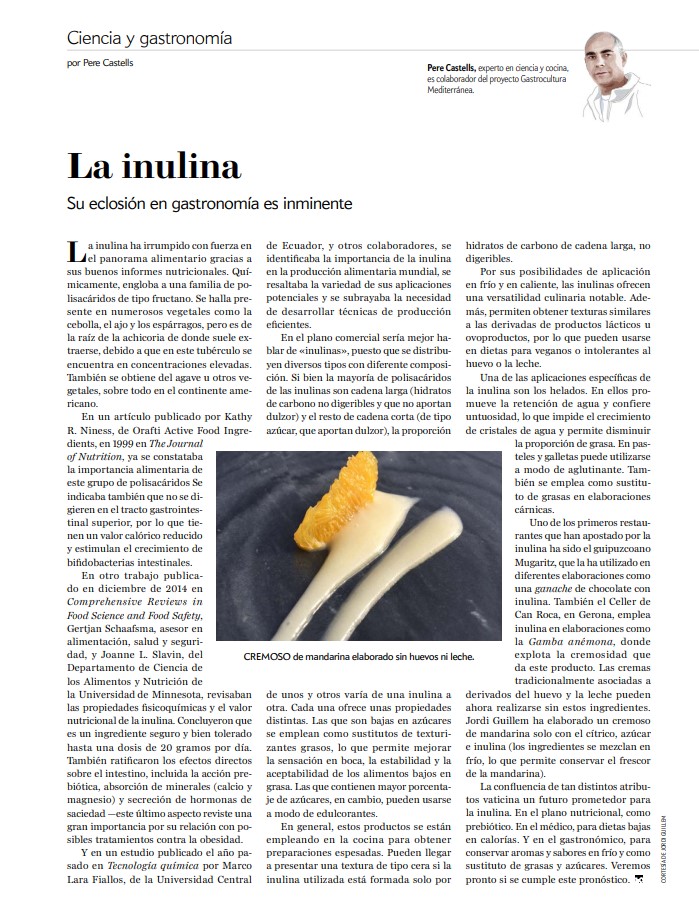500 gr. Orange juice
150 gr. Sugar
220 gr. Töufood Inülin
Mix the ingredients in cold.
Disperse with strong agitation.
Let the mixture stand for a minimum of 3-4 hours.
When creating a pastry recipe, such as creams, mousses or compotes, which contain a lot of water or require freezing, controlling the amount of free water and its activity becomes critical.
Water can be controlled in a recipe with different techniques, but this often means relying on ingredients with a high percentage of dry matter, such as fats or sugars.
Inulin is an ingredient that not only acts as a “solid”, thanks to the dry extract, but also has a high water binding capacity (also called water retention capacity) and properties similar to those of fat or sugar.
Inulinis a non-digestible carbohydrate also called fructan, which belongs to the polysaccharide group.
It consists of linear chains of fructose linked to a glucose molecule. It is naturally present in many vegetables, fruits and cereals: chicory root, dandelion root, asparagus, leeks, onions, bananas, bananas, sprouted wheat, garlic, artichokes, etc….
Powdered inulin is mainly extracted from chicory root, although other variants are also extracted from a variety of the agave plant.
Technically, inulin is an interesting product because it consists of almost 100% dry extract, has a high water binding capacity and minimal sweetening power (in the case of Inülin Waxy null).
Also, due to its technical properties, it has an enormous structural power that allows it to replace fats and sugars in conventional recipes and to achieve textures ranging from smooth butter to waxy textures.
It also provides stability during the thawed freezing process, slightly lowers the freezing point and inhibits the growth of water crystals.
In addition to its functional properties, one of the great benefits of working with inulin is its nutritional benefits.
Being a prebiotic and a dietary fiber of natural origin, it helps to lower lipid, cholesterol and blood glucose levels.
The energy value of inulin is about 200 kcal / 100 g, which represents a considerable reduction compared to other ingredients, such as sugar, which contributes about 380 kcal / 100 g.
In addition, it has a significantly low glycemic index and does not influence blood glucose levels as much as sugar.
Diabetics can consume inulin due to its low glycemic index (14), although in moderation and within the recommended daily dose.
It is a gluten-free product and therefore suitable for coeliacs.
When we replace sugars or part of the sugars with inulin, we obtain stable textures that withstand freezing well, with balanced sweetness levels.
We also do not lose sight of our fundamental objective: to enhance the flavor of the main ingredient and satisfy the needs of the chef and the end consumer.
When sugar is replaced by inulin, it is not done with a 1:1 ratio.
We use inulin when we want to reduce the amount of sugar in the recipe or when we need more dry extract, but do not want to use more fats or sugars.
Normally, we are not looking to replace 100% of the sugar (which would mean using 10 times more inulin than sugar to achieve the same level of sweetness), but rather to achieve recipe stability by using healthier ingredients.
We looked at the amount of dry extract needed to stabilize the recipe and started by replacing part of the sugar with inulin.
Depending on the desired sweetness level and the type of preparation, we adjust the amount of inulin to the recipe.
To use it, it is mixed cold or hot with strong agitation for a reasonable time and it is recommended to strain the mixture before it texturizes to avoid a sandy mouth texture.
In the case of Inülin Waxy this step is essential.
It has interesting applications in ice cream making, allowing to obtain smoothness by lowering the proportion of fat and as a product to retain water.
A dose of between 50 and 500 gr is recommended. / L. according to the desired hardness and texture.


TÖUFOOD is a complete line of products of exceptional quality, developed by GASTROCULTURA MEDITERRÁNEA SL, which allows the most well-known techniques of modern cuisine to be put into practice. Innovative recipes can be easily realised, bringing excitement and surprise to dishes, offering a stimulating and memorable culinary experience.